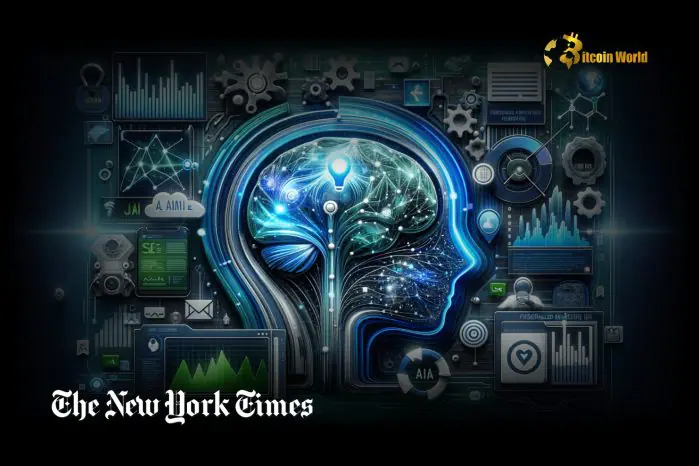In a potentially revolutionary shift for the media landscape, even as cryptocurrency and blockchain technologies reshape digital interactions, The New York Times has announced it will embrace artificial intelligence. Yes, you heard that right! The paper, known for its commitment to traditional journalism, is now giving its product and editorial teams the green light to use AI tools. This is particularly noteworthy as it unfolds against the backdrop of their ongoing copyright lawsuit against AI giants OpenAI and Microsoft. For those in the crypto and decentralized tech space, always keen on disruptive technologies, this move by a legacy media institution signals a significant moment in the evolution of content creation and news dissemination.
Why is the New York Times Embracing AI Tools Now?
The news, initially reported by Semafor, came via an internal email to the NYT staff. The publication unveiled its in-house generative AI summary tool, named ‘Echo.’ But it’s not just about summaries. The New York Times is offering a suite of AI tools to help staff build web products and brainstorm editorial ideas. This includes access to programs like GitHub Copilot for coding, Google Vertex AI for product development, NotebookLM, select Amazon AI products, and OpenAI’s non-ChatGPT API through a business account. Why this sudden pivot towards AI? Here’s a breakdown:
- Efficiency Boost: AI can automate time-consuming tasks, freeing up journalists to focus on in-depth reporting and investigative journalism. Think faster SEO headline generation and quicker social media copy drafting.
- Innovation in Storytelling: Generative AI can help in brainstorming fresh angles, suggesting diverse interview questions, and even assisting with complex research tasks.
- Expanding Reach: The guidelines hint at potential future applications like AI-powered article translations and digitally voiced articles, broadening the NYT’s accessibility to a global audience.
However, this embrace of AI tools comes with crucial caveats.
The Guardrails: How Will Editorial Staff Use AI?
While the NYT is encouraging the use of AI tools, they are also setting firm boundaries for their editorial staff. Here’s what’s permitted and what’s off-limits:
| Permitted Uses of AI | Prohibited Uses of AI |
|---|---|
| Suggesting edits and improvements to articles | Drafting or significantly revising entire articles |
| Brainstorming interview questions | Inputting confidential source information into AI systems |
| Assisting with research tasks and data analysis | Using AI to replace core journalistic judgment and reporting |
| Generating SEO headlines and social media copy | Relying solely on AI for fact-checking or verification |
These guidelines clearly indicate that The New York Times views AI as a supportive tool, not a replacement for human journalists. The emphasis remains on leveraging AI to enhance productivity and explore new creative avenues, while maintaining journalistic integrity and human oversight.
The Irony: AI Adoption Amidst a Copyright Lawsuit
Perhaps the most intriguing aspect of this development is the backdrop of the NYT’s copyright lawsuit against OpenAI and Microsoft. The lawsuit alleges that these AI companies violated copyright laws by training their generative AI models on The New York Times’ copyrighted content without permission. This move to integrate AI tools internally, while simultaneously suing AI companies, presents a complex and somewhat paradoxical situation. It highlights a crucial tension many industries are grappling with:
- Embracing Innovation vs. Protecting Rights: The NYT seems to be navigating the fine line between leveraging the benefits of AI to stay competitive and safeguarding their intellectual property.
- Defining Fair Use in the AI Era: The lawsuit itself is a landmark case that could set precedents for how copyright law applies to the training of generative AI models.
- The Future of Content Creation: The NYT’s internal adoption of AI tools suggests a future where AI and human journalists collaborate, but the legal and ethical frameworks are still being defined.
What Does This Mean for the Future of Media and Beyond?
The New York Times’ decision to incorporate AI tools, despite their ongoing legal battle, is a bellwether moment for the media industry and potentially other sectors dealing with digital content and copyright lawsuit concerns. Here are some potential implications:
- Wider Adoption of AI in Media: If a traditional giant like the NYT embraces AI, it could encourage other news organizations to explore and integrate AI tools into their workflows.
- Evolving Journalistic Roles: Journalists may increasingly become curators and editors of AI-generated content, focusing on verification, in-depth analysis, and original reporting that AI cannot replicate.
- New Business Models: The integration of generative AI might lead to new revenue streams and content formats in the media industry, such as personalized news feeds or AI-driven content recommendations.
- Legal and Ethical Debates Intensify: The NYT’s lawsuit underscores the ongoing need for clearer legal and ethical guidelines surrounding AI, copyright, and the use of data for training AI models.
Conclusion: A Strategic Balancing Act
The New York Times’ move to adopt AI tools for its editorial staff while pursuing a copyright lawsuit against AI companies is a fascinating study in strategic maneuvering. It’s a clear signal that even while fiercely protecting their intellectual property, legacy media institutions recognize the transformative potential of generative AI. This dual approach – embracing AI’s capabilities while challenging its unchecked use of copyrighted material – could become a model for other industries navigating the complex AI landscape. For the crypto and blockchain community, accustomed to rapid technological evolution and disruptive innovation, this development at The New York Times serves as a potent reminder that even established institutions are being profoundly shaped by the AI revolution.
To learn more about the latest AI market trends, explore our article on key developments shaping AI features.
Disclaimer: The information provided is not trading advice, Bitcoinworld.co.in holds no liability for any investments made based on the information provided on this page. We strongly recommend independent research and/or consultation with a qualified professional before making any investment decisions.


